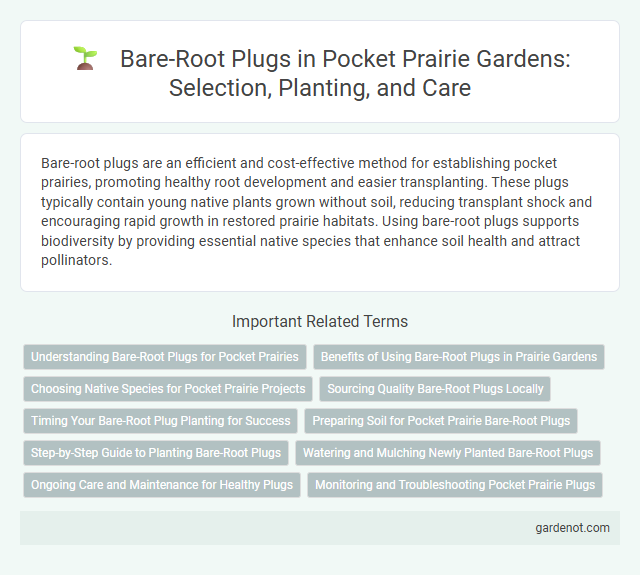Bare-root plugs are an efficient and cost-effective method for establishing pocket prairies, promoting healthy root development and easier transplanting. These plugs typically contain young native plants grown without soil, reducing transplant shock and encouraging rapid growth in restored prairie habitats. Using bare-root plugs supports biodiversity by providing essential native species that enhance soil health and attract pollinators.
Understanding Bare-Root Plugs for Pocket Prairies
Bare-root plugs are young plants grown without soil, making them lightweight and easy to handle for pocket prairies. These plugs establish quickly when planted in well-prepared soil, promoting deep root growth essential for drought resilience. Selecting native species in bare-root plugs enhances biodiversity and supports pollinators in small-scale prairie restoration projects.
Benefits of Using Bare-Root Plugs in Prairie Gardens
Bare-root plugs offer significant benefits for prairie gardens by promoting robust root development and healthier plant establishment compared to container-grown alternatives. These plugs minimize transplant shock and encourage deeper root systems, essential for drought resilience and nutrient uptake in native prairie ecosystems. Using bare-root plugs enhances survival rates, reduces planting costs, and supports sustainable restoration efforts.
Choosing Native Species for Pocket Prairie Projects
Selecting native species for bare-root plugs in pocket prairie projects enhances plant establishment and biodiversity by matching local soil and climate conditions. Species such as little bluestem (Schizachyrium scoparium), purple coneflower (Echinacea purpurea), and black-eyed Susan (Rudbeckia hirta) thrive in native prairie habitats and support pollinators and wildlife. Using bare-root plugs of these adapted plants ensures deep root development, improving drought resistance and long-term prairie stability.
Sourcing Quality Bare-Root Plugs Locally
Sourcing quality bare-root plugs locally ensures healthier establishment and better adaptation to pocket prairies' native conditions. Local nurseries specializing in native plants often provide bare-root plugs that are well-suited to regional soil and climate, enhancing survival rates. Procuring bare-root plugs from nearby sources reduces transportation stress and promotes sustainable restoration efforts in pocket prairie projects.
Timing Your Bare-Root Plug Planting for Success
Timing your bare-root plug planting is crucial for establishing a healthy pocket prairie, with early spring being the ideal period when the soil begins to warm but before full leaf-out. Planting during this window ensures roots can establish before summer drought stress while avoiding frost damage that could hinder growth. Monitoring soil temperature and moisture levels enhances plug survival, promoting robust native plant development in your pocket prairie ecosystem.
Preparing Soil for Pocket Prairie Bare-Root Plugs
Preparing soil for pocket prairie bare-root plugs involves loosening the soil to a depth of at least 12 inches to enhance root penetration and aeration. Incorporate organic matter such as compost or aged manure to improve soil fertility and moisture retention, creating an optimal environment for bare-root plugs to establish. Ensure the soil is well-drained with a neutral to slightly acidic pH, as this supports healthy root growth and increases survival rates of pocket prairie plants.
Step-by-Step Guide to Planting Bare-Root Plugs
Plant bare-root plugs in early spring or late fall when soil is moist and temperatures are cool to encourage strong root establishment. Dig a hole slightly larger than the root system, gently spread the roots, and backfill with native soil to eliminate air pockets. Water thoroughly after planting and apply a thin layer of mulch to retain moisture and suppress weeds.
Watering and Mulching Newly Planted Bare-Root Plugs
Watering newly planted bare-root plugs requires consistent moisture to ensure root establishment without waterlogging, ideally applying 1-2 inches of water weekly. Mulching with organic materials like wood chips or straw helps retain soil moisture, regulate temperature, and suppress weeds around the plugs. Proper watering combined with a 2-3 inch mulch layer significantly improves the survival and growth rates of pocket prairie bare-root plugs.
Ongoing Care and Maintenance for Healthy Plugs
Bare-root plugs in pocket prairies require consistent watering, especially during the first growing season, to ensure root establishment and prevent drought stress. Applying a layer of mulch around the plugs helps retain soil moisture and suppresses weed growth, promoting healthy development. Regular monitoring for pests and diseases, along with timely removal of invasive species, supports long-term plug vitality and overall prairie ecosystem health.
Monitoring and Troubleshooting Pocket Prairie Plugs
Monitoring bare-root plugs in pocket prairies involves regular inspection for moisture levels, ensuring the soil remains consistently damp but not waterlogged. Troubleshooting common issues includes addressing root desiccation by improving irrigation methods and managing pest infestations through integrated pest management practices. Maintaining optimal conditions during establishment maximizes plug survival and promotes healthy prairie plant development.
Bare-root plug Infographic

 gardenot.com
gardenot.com